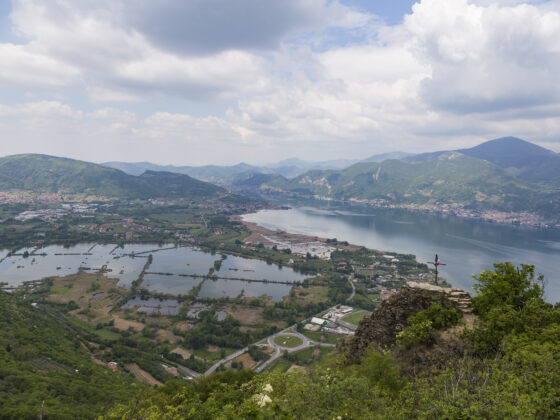STAGE 5 - Provaglio d’Iseo, Iseo, Monticelli Brusati, Ome, Rodengo Saiano, Gussago
- Start: Provaglio d’Iseo
- Arrival: Gussago
- Total Length: 23,5 km
- Difficulty by Foot: Hard
- Climb up: 824 m
In every route there is a challenging stage which puts your legs and mind to the test. For Via delle Sorelle, it’s this stage. You start uphill to reach Madonna del Corno di Provaglio d'Iseo, a 16th-century church overlooking Torbiere del Sebino Peat Bog Nature Reserve, and then reach, via a steep trail, Corno del Creilì peak to enjoy the most spectacular view of the entire trail. All your efforts will be worth it. And then again: Sentiero delle Cascate (Waterfall trail) in Monticelli, Borgo del Maglio (Forge) in Ome, the Abbey of Rodengo-Saiano and the village of Gussago with its Santissima church.
The fifth stage begins immediately with a challenge: the direct ascent from Madonna del Corno di Provaglio to Corno del Creilì peak from where there is the most spectacular view of the entire trail, with its postcard-perfect panorama of Lake Iseo and Montisola - the largest lake island in Europe - Torbiere del Sebino Peat Bog Reserve, and the surrounding hills and peaks. You descend to Sentiero delle Cascate in Monticelli Brusati, a scattered municipality, and arrive near the castle. Cross the town in the direction of Ome and its Borgo del Maglio. Then, go across Bosco delle Querce (oak park) and proceed towards the municipality of Rodengo-Saiano along the Gandovere stream and passing in front of the ancient Olivetan Abbey. Through fields and vineyards, you reach Gussago, where you can choose to take a detour to reach the former Dominican complex of the Santissima, an evocative viewpoint, or circle around Colle Barbisone hill and reach the centre of Gussago.
Natural POIs: Corno del Creilì, Bosco delle Querce
Municipalities crossed: Provaglio d'Iseo, Iseo, Monticelli Brusati, Ome, Rodengo Saiano, Gussago
ROUTES CROSSED: Sentiero delle Cascate (Waterfall Trail), Antica Via Valeriana
Low Variant. For those who do not feel up to the climb to Madonna del Corno and the subsequent climb to the summit of Monte Cognolo, or in case of bad weather, an alternative route has been designed. It is marked as Variante Bassa - low variant. Full details here.
STAGE 5 - Provaglio d’Iseo, Iseo, Monticelli Brusati, Ome, Rodengo Saiano, Gussago

- Start: Provaglio d’Iseo
- Arrival: Gussago
- Total Length: 23,5 km
- Difficulty by Foot: Hard
- Climb up: 824 m
In every route there is a challenging stage which puts your legs and mind to the test. For Via delle Sorelle, it’s this stage. You start uphill to reach Madonna del Corno di Provaglio d'Iseo, a 16th-century church overlooking Torbiere del Sebino Peat Bog Nature Reserve, and then reach, via a steep trail, Corno del Creilì peak to enjoy the most spectacular view of the entire trail. All your efforts will be worth it. And then again: Sentiero delle Cascate (Waterfall trail) in Monticelli, Borgo del Maglio (Forge) in Ome, the Abbey of Rodengo-Saiano and the village of Gussago with its Santissima church.
The fifth stage begins immediately with a challenge: the direct ascent from Madonna del Corno di Provaglio to Corno del Creilì peak from where there is the most spectacular view of the entire trail, with its postcard-perfect panorama of Lake Iseo and Montisola - the largest lake island in Europe - Torbiere del Sebino Peat Bog Reserve, and the surrounding hills and peaks. You descend to Sentiero delle Cascate in Monticelli Brusati, a scattered municipality, and arrive near the castle. Cross the town in the direction of Ome and its Borgo del Maglio. Then, go across Bosco delle Querce (oak park) and proceed towards the municipality of Rodengo-Saiano along the Gandovere stream and passing in front of the ancient Olivetan Abbey. Through fields and vineyards, you reach Gussago, where you can choose to take a detour to reach the former Dominican complex of the Santissima, an evocative viewpoint, or circle around Colle Barbisone hill and reach the centre of Gussago.
Natural POIs: Corno del Creilì, Bosco delle Querce
Municipalities crossed: Provaglio d'Iseo, Iseo, Monticelli Brusati, Ome, Rodengo Saiano, Gussago
ROUTES CROSSED: Sentiero delle Cascate (Waterfall Trail), Antica Via Valeriana
Low Variant. For those who do not feel up to the climb to Madonna del Corno and the subsequent climb to the summit of Monte Cognolo, or in case of bad weather, an alternative route has been designed. It is marked as Variante Bassa - low variant. Full details here.
